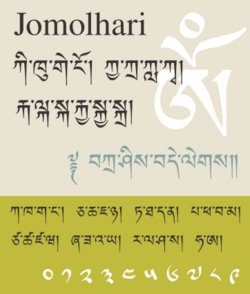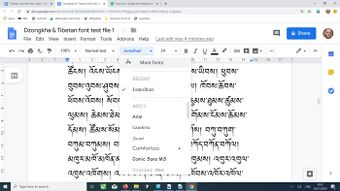Jomolhari (typeface)
 | |
| Classification | Non-Latin |
|---|---|
| Designer(s) | Christopher Fynn |
| License | SIL Open Font License |
Jomolhari is a Tibetan script Uchen font created by Christopher Fynn, freely available under the Open Font License. It supports text encoded using the Unicode Standard and the Chinese national standard for encoding characters of the Tibetan script (GB/T20524-2006 "Tibetan Coded Character Set"). The design of the font is based on Bhutanese manuscript examples[1] and it is suitable for text in Tibetan, Dzongkha and other languages written in the Tibetan script.
Format and License
The Jomolhari font is available in OpenType format using TrueType outlines. It is distributed under the terms of the SIL Open Font License.
It may be downloaded from Google Fonts, the Free Tibetan Fonts Project on the Savannah site and several other places. The VOLT project files containing the source of the OpenType lookups in the font are also available on the Savannah site.
It is also available in deb and rpm packages for Linux.
Usage
- The Jomolhari font is included with many Linux distributions including:
- Jomolhari is used as the principal font of several Bhutanese newspapers for their Dzongkha language editions or sections including:
- Bhutan Observer
- Bhutan Times
- Bhutan Today
- Business Bhutan
- Druk Yoedzer
- Jomolhari is the default Tibetan script font being used by MediaWiki[5] (including Wikipedia).
- Jomolhari is the font used for the website of the National Library of Bhutan for their Dzongkha language pages[6]
- Jomolhari is also available for typing Dzongkha or Tibetan text in Google Docs.
Derivative works
Jomolhari ID was a fork of Jomolhari to create a font that worked in Adobe InDesign CS3 and CS4, which lacked specific support for Tibetan script. This font included additional general OpenType lookups and features in the font enabling it to work in these versions of InDesign.[7][8] These additional lookups were later incorporated into the standard Jomolhari font.
Andrew West also created a fork of Jomolhari to add extended support for Tibetan: BabelStone Tibetan. This font added some additional Tibetan characters encoded in a later version of Unicode, added more clusters especially for writing Tibetan shorthand contractions and transcribing Tangut.[9]
References
- ↑ "Free Tibetan Fonts Project". Free Tibetan Fonts Project. http://savannah.nongnu.org/projects/free-tibetan.
- ↑ "Jomolhari fonts". Fedora Project. https://fedoraproject.org/wiki/Jomolhari_fonts.
- ↑ "ttf-dzongkha". Debian Project. http://packages.qa.debian.org/t/ttf-dzongkha.html.
- ↑ "fonts-dzongkha". Debian Project. https://packages.qa.debian.org/f/fonts-dzongkha.html.
- ↑ "Universal Language Selector/WebFonts". WikiMedia.org. http://www.mediawiki.org/wiki/Universal_Language_Selector/WebFonts#Table_of_languages_and_default_fonts.
- ↑ "Fonts". National Library of Bhutan. http://www.library.gov.bt/IT/fonts.html.
- ↑ "Jomolhari ID". http://www.thlib.org/tools/#wiki=/access/wiki/site/26a34146-33a6-48ce-001e-f16ce7908a6a/jomolhari%20id.html.
- ↑ "Tibetan Fonts". http://www.digitaltibetan.org/index.php/Tibetan_Fonts.
- ↑ Andrew West. "BabelStone Fonts: BabelStone Tibetan". http://www.babelstone.co.uk/Fonts/Tibetan.html.
External links
- Free Tibetan Fonts Project
- Jomolhari FlipFont installer for Samsung devices
- Tibetan Fonts at Digital Tibetan Wiki
- Jomolhari on Google Fonts


